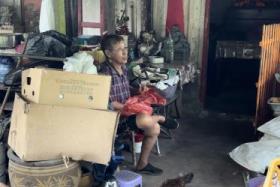'Old' Dakota Crescent won't disappear completely
Redevelopment of historic estate will involve new public flats, 'adaptive reuse' of old blocks
Dakota Crescent, one of Singapore's oldest public housing estates, will start a fresh chapter when new public flats are built there, but it will not turn the page entirely on the past. The historic estate's courtyard and iconic dove playground will be retained, along with the six blocks around them.
These will be "repurposed for civic and community uses", Minister for National Development Lawrence Wong said in a Facebook post yesterday.
His announcement was welcomed by those advocating for the preservation of the 59-year-old estate.
Dakota Crescent's 17 low-rise blocks with 648 units off Old Airport Road were developed by the Singapore Improvement Trust (SIT) in 1958 as a public rental housing estate and handed over to the Housing and Development Board (HDB) in 1960 - the year the statutory board was formed.
The estate was named after the Douglas DC-3 Dakota, a model of plane that used to land at Kallang Airport.
In 2014, the Government said the estate would make way for developments under renewal plans for Mountbatten, and residents had till the end of last year to vacate their flats.
Of the 17 blocks, which had hardly changed in 60 years, two blocks - Blocks 13 and 21 across Old Airport Road - have been kept for interim use under the Parenthood Provisional Housing Scheme. This scheme allows young couples waiting for their new flats to be built to have a place to live in the meantime.
Blocks 10, 12, 14, 16, 18 and 20, the central cluster of blocks around the playground, will be kept.
These comprise two seven-storey curved "butterfly" blocks, two seven-storey slab blocks, one three-storey block, and a two-storey block - all representative of the four types of SIT buildings.
Mr Wong said in his Facebook post that redeveloping the estate for public housing "will provide more public housing options near the city, and allow another generation of Singaporeans to build their own memories of the place".
"To achieve this, we will need new HDB flats in the estate that can better serve the housing needs of Singaporeans," he added.
Mr Wong said the redeveloped estate could be a mixed-use area with new HDB flats, "adaptive reuse" of some of the old blocks, and amenities and community spaces.
An Urban Redevelopment Authority spokesman said agencies are still working out possible options for reuse, which could range from "community uses" on the ground floor to work spaces or hostels on the upper floors.
MP for Mountbatten Lim Biow Chuan, who had previously called on the Government to reconsider plans to redevelop the historic estate, was "pleased" with the decision to retain the six blocks.
"It's not just about retaining buildings, but retaining memories. A lot of residents spent time at the playground," Mr Lim said.
He welcomed the move to use the estate for public housing, which he said would keep the area accessible to the public and expressed hope the six repurposed blocks will not be filled with offices and commercial properties that "would take away the essence of what Dakota Cresent was".
Get The New Paper on your phone with the free TNP app. Download from the Apple App Store or Google Play Store now


